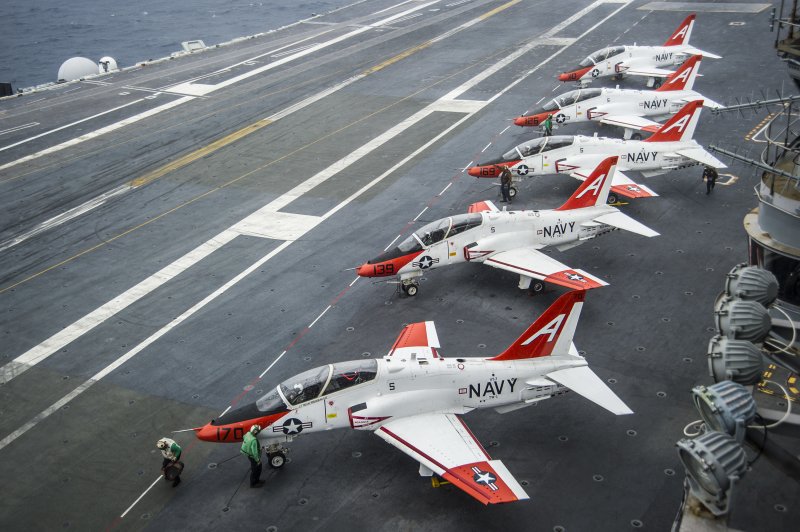Investigators say the T-45C Goshawk that crashed on Oct. 1 has again raised issues about the training aircraft, which were grounded briefly in April for an investigation into concerns about the plane's oxygen system. Investigators say the problematic oxygen system was installed on the T-45C that crashed most recently, though they have not blamed it for the crash. Pictured, T-45C Goshawks from Training Air Wing One 1 on the flight deck of the aircraft carrier USS George Washington. U.S. Navy photo by Petty Officer 2nd Class Bryan Mai
Oct. 6 (UPI) -- As the names of two dead U.S. Navy pilots are released following the Sunday crash of a military training jet in a remote area of Tennessee, lawmakers and military commanders face troubling questions.
Lt. Patrick L. Ruth, 31, of Metairie, La., and Lt. j.g. Wallace E. Burch, 25, of Horn Lake, Miss., died when their T-45C Goshawk, a military jet-training aircraft manufactured by Boeing since 1997, crashed in the Tellico plains of the Cherokee National Forest, some 45 miles southwest of Knoxville, officials said this week.
It was the third incident this year involving the T-45C Goshawk and first since the trainer fleet was briefly grounded to investigate concerns about its oxygen system.
The T-45C that crashed most recently had the CRU-123 oxygen monitoring system installed, the Navy said Friday, which was added to the fleet last spring as part of a fix for the previous issues with the oxygen system.
Sen. Roger Wicker, R-Miss., called for an immediate investigation.
"I am deeply saddened to learn that two of our nation's best have been taken from us. I offer my condolences to their families and fellow service members," Wicker said in a statement Tuesday. "May God grant peace to their loved ones during this very difficult time. The Navy should conduct an immediate investigation into what caused this tragedy."
Wicker, a retired U.S. Air Force lieutenant colonel, serves as chairman of the Senate Subcommittee on Seapower, which has oversight jurisdiction for the Navy and naval aviation. The plane that crashed Sunday was based a Naval Air Station Meridian in Mississippi, one of five naval air training wings.
Wicker conducted hearings in April with Navy officials and pilots at Meridian to discuss issues related to a lack of flowing oxygen for pilots operating the T-45C. About 100 Navy instructor aviators were opting out of training student pilots over safety concerns, which contributed to the cancellation of training flights at the time.
In the same month, Vice Chief of Naval Operations Adm. Bill Moran ordered a review of "physiological episodes" occurring in T-45s and F/A-18 Super Hornets as additional reports surfaced of hypoxia-related incidents that could incapacitate its crew during flight as the Navy temporarily grounded its T-45C trainer aircraft fleet.
Former Navy fighter pilot and F/A-18 standardization instructor and flight operations director Benjamin Kohlmann told UPI that hypoxia-related incidents were rare during his time in the Navy from 2004 to 2013, lamenting that the problem has only risen to prominence in the last few years.
"I don't know what's causing it, maybe more attention is being paid to the issue, perhaps errors or mishaps that occurred in the past were not attributed to hypoxia-related incidents, but now are," Kohlmann said. "It's a mystery as to what the full extent of it is."
Hypoxia-related incidents occur when there is an inadequate amount of partial pressure of oxygen in the air.
"At a certain attitude, the concentration of air is insufficient to provide someone with human cognition," Kohlmann said. "The rule of thumb is that above 10,000 feet, prolonged exposure isn't going to give you enough oxygen to do the day-to-day things that you need to survive, so we rely heavily on those oxygen systems."
This year's defense bill includes a provision that was successfully added by Wicker and designed to assist military commanders in identifying the cause of physiological episodes. The plan would give authorization to Defense Secretary James Mattis to award a $10 million defense contract to think tanks, academic institutions or private industry professionals to investigate the cause of the phenomenon.
Details surrounding the cause of the crash in Tennessee are still preliminary amid an ongoing investigation, with Navy investigators arriving the day after the crash. The U.S. National Forest Service has closed parts of the Tellico Ranger District from public access until the investigation is completed.
Both pilots were assigned to the "Eagles" of Training Squadron SEVEN, or VT-7. Ruth was a seasoned naval aviator with nine years of service and was instructing his student, Burch, who had joined VT-7 in 2016 and had been in the Navy for almost three years.
Student pilots begin training on the T-45C after logging adequate flight hours on propeller aircraft and is used for the ultimate purpose of preparing naval pilots for operating the F/A-18 E/F Super Hornet or the F-35 Lighting II, the Pentagon's latest joint strike fighter. Graduating the training course with more than 150 flight hours on top of additional training hours, according to Kohlmann.
Officials face a debris area that is roughly the size of almost nine football fields, that is spread across remote, arduous terrain made up of dense forest wilderness, making access to aircraft parts difficult and the investigation road to answers long.















